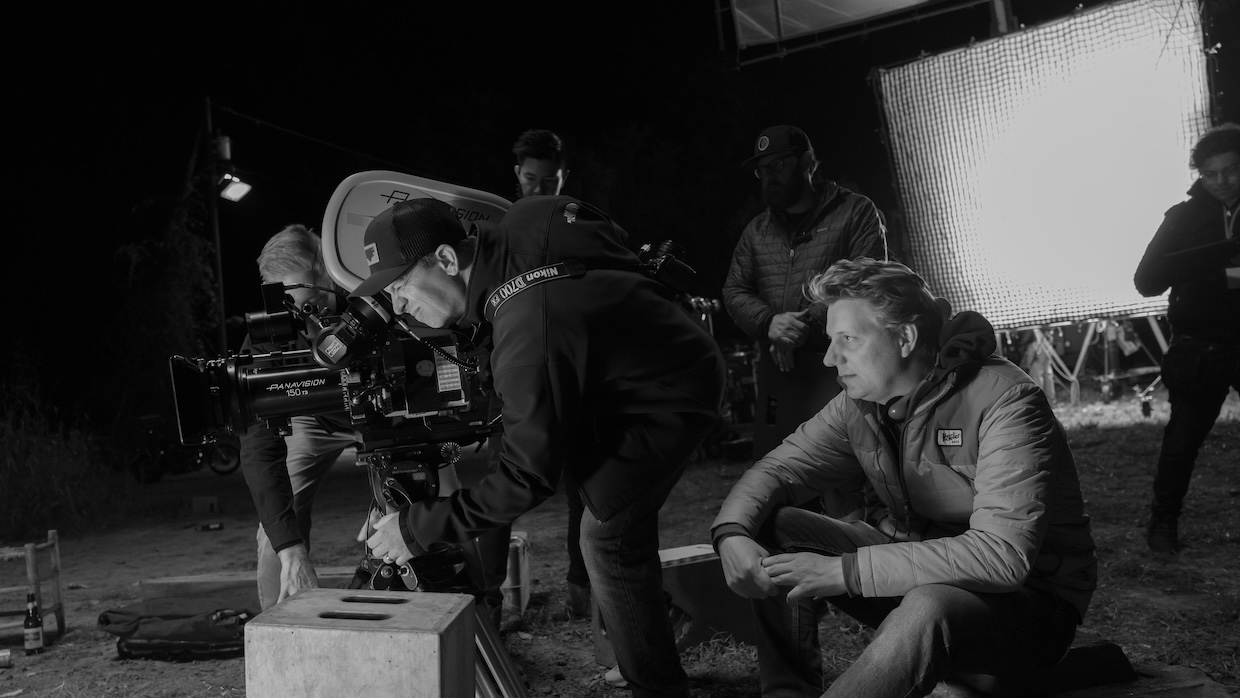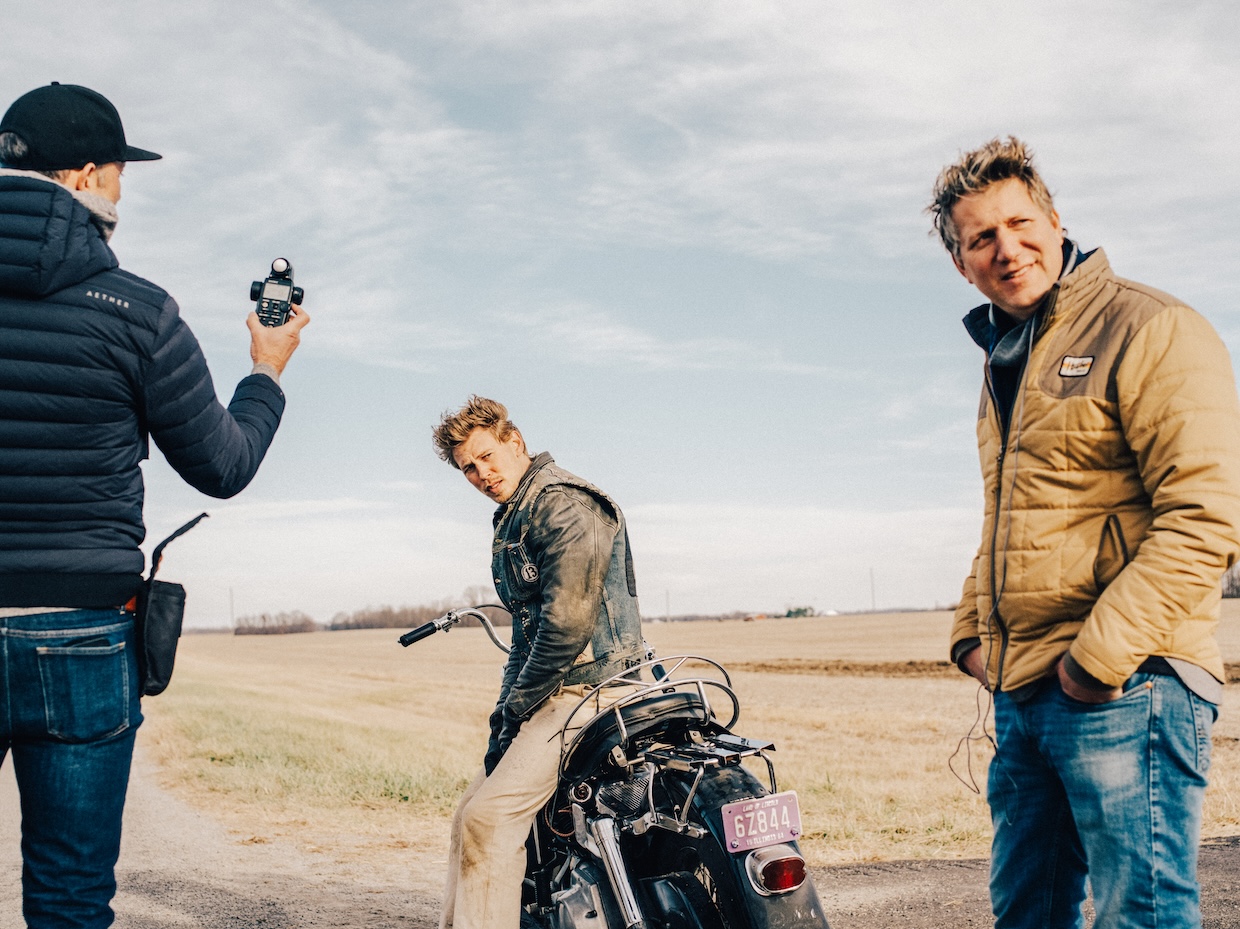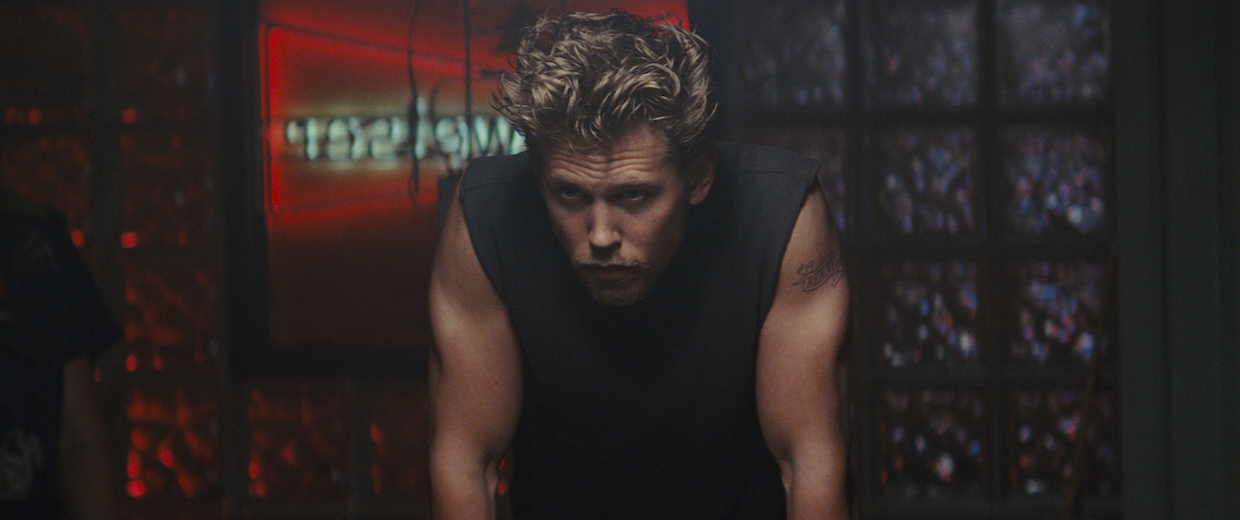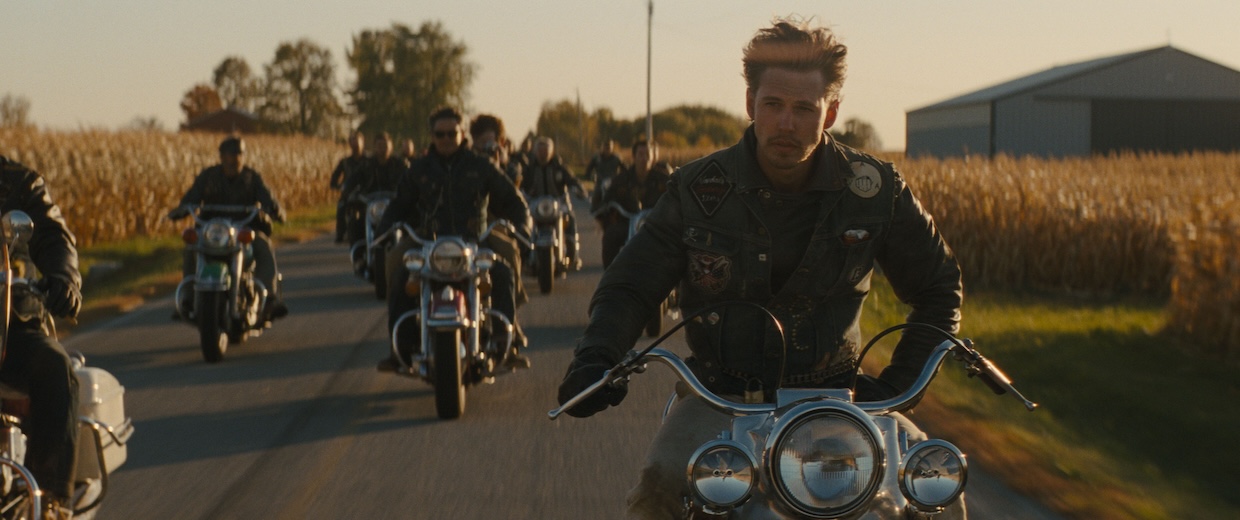 Back to selection
Back to selection
Shutter Angles
Conversations with DPs, directors and below-the-line crew by Matt Mulcahey
“Shooting on Film Remains Somewhat of a Black Art”: DP Adam Stone on The Bikeriders
 Adam Stone and Jeff Nichols on the set of The Bikeriders
Adam Stone and Jeff Nichols on the set of The Bikeriders After eight years—much of them spent developing projects that never came to fruition—Mud and Midnight Special filmmaker Jeff Nichols is thankfully back with a new movie.
That means cinematographer Adam Stone is back with a new movie too.
After meeting Nichols at the University of North Carolina School for the Arts, Stone has been behind the camera on all six of the director’s features. Every one of them has been shot on 35mm, including the pair’s latest collaboration, The Bikeriders.
Lensed in and around Cincinnati, the movie takes its inspiration from the photographs and stories in Danny Lyon’s titular 1968 book about a Chicago motorcycle club. The fictionalized film version centers on an idealized rebel, Benny (Austin Butler), as he’s pulled between Kathy (Jodie Comer), the wife who wants him to quit riding, and Johnny (Tom Hardy), the gang leader who wants him to take over the club.
Stone spoke to Filmmaker about reshooting the movie’s final scene, employing trikes to capture the actors in motion and the various tragedies that have befallen his favorite Sekonic light meter.
Filmmaker: I had two cinematographers recently—Ben Fordesman for Love Lies Bleeding and Shane Kelly for Hit Man—talk about how they hoped to use 35mm on their projects but were not able to. You and Jeff Nichols have shot all of your films together on 35mm, but it’s been a while since Loving and Midnight Special both came out in 2016. Was it more difficult on The Bikeriders than in the past to convince the powers that be that shooting on film was a necessity?
Stone: It has been quite a while since Jeff and I shot a film together, but nothing has really changed. We always shoot on celluloid—it’s basically a mandate for us. We did go back and forth with the studio and producers about whether to shoot in 70mm or 35mm. We wanted to use 70mm, but the truncated shooting schedule and the need to work around motorcycles at speed didn’t suit the larger format.
Filmmaker: I know it can be hard to quantify, but can you articulate what 35mm still gives you at this point that digital just doesn’t? Digital cameras have come a long way since the days when you and Jeff were making Shotgun Stories. What keeps drawing you back to film?
Stone: I love celluloid because it’s magical and nuanced. Despite being around for over a century and being used by incredibly talented craftspeople to create beautiful images, shooting on film remains somewhat of a black art. It’s mysterious and unpredictable; you never quite know what the final product will look like due to the many potential aberrations. That unpredictability is what makes shooting on film so pleasing. It isn’t as precise or scrutinized as digital, and there’s an intrinsic beauty in celluloid that digital simply can’t achieve.
Filmmaker: There’s a behind the scenes photo of you in the Bikeriders press materials taking a reading with your light meter. Is there a story behind that meter? Is it the same one from Loving/Midnight Special?
Stone: I have two light meters, a Sekonic and a Minolta. Both are old but still up to the task. The Minolta, my back-up, is the eldest, and I’ve had it since the days of David Gordon Green’s All the Real Girls. I’ve replaced the Sekonic on several occasions. It went for a swim in the Mississippi while shooting Mud and got run over by a grip truck on Midnight Special.
Filmmaker: I believe you’ve shot all of your films with Jeff except Take Shelter with anamorphic lenses. The last four have all been with Panavision G Series lenses. What do you love about those lenses? Have you had them detuned from movie to movie to tweak the look?
Stone: The G Series lenses are my favorite. I won’t bore you with all the technical details about their gorgeous bokeh, balanced aberration and fall-off. What I love about the G Series is how real they make everything look—just like what my eyes see. Regardless of the situation, I can always rely on the G Series to deliver a beautiful image and a stately frame. I’ve never needed to detune them.
Filmmaker: Tell me about your approach to shooting Benny. From his introduction leaning on a pool table—based on a Danny Lyon photo—there’s just something about the way you compose Benny and the way Austin Butler moves that encapsulates what attracts Kathy and Tom Hardy’s character (and the viewer) to him. It’s similar to what attracts Hardy’s Johnny when he sees Brando in The Wild One on TV. How do you go about shooting a character in a way that makes them mythic or idealized without any fancy tricks like slow-motion, non-realistic lighting or unusual camera angles?
Stone: That’s a very kind sentiment. Austin Butler embodies coolness and is an immense talent, so making him look iconic isn’t too hard. There isn’t any special formula for making a character look iconic. Jeff and I simply strive to make our sets as realistic as possible so the actors don’t feel like they’re playing dress-up or make-believe. We want them to inhabit authentic environments, allowing them to express themselves fully without distraction. Whether it’s putting a boat in a tree [for Mud] or recreating a bar exactly as pictured in Danny Lyon’s book, the iconic moments come to life thanks to the hard work of our crew. Their attention to detail in art direction, costuming and lighting allows us to capture some truly magical moments.
Filmmaker: Walk me through the different camera platforms you used to capture the shots of the riders in motion on their bikes.
Stone: We experimented with various methods for shooting actors on bikes. Each situation required a unique piece of equipment. Ultimately, we used three different shooting platforms for the film: an eBike with a stabilized head, a pursuit car with a stabilized head and a trike with a camera platform. The eBike and pursuit car were used for wide shots of the bikers in formation, which were crucial for adding credibility to the film. The trike was used exclusively for close-ups of the actors riding. We constructed a platform around the trike, allowing the actor to drive while the camera operator captured close-up shots. This technique really immersed the audience in the shot because it was so interpersonal, and in close proximity to the actors’ faces. You actually felt as if you were on the bike with them.
Filmmaker: The story is told at times from the perspective of both Kathy and Danny Lyon—both part of the Vandals club in a peripheral way, but not really members. How did telling the story from the lens of those more objective observers affect where you put the camera?
Stone: For a bit of backstory: Danny Lyon not only took thousands of photographs of the bike gang but also conducted many hours of audio interviews on reel-to-reel tape. The most compelling interviews were with Kathy, which is why Jeff centered the story around her. Kathy was the catalyst and anchor of the story, so the camera naturally focused heavily on her, resulting in more close-ups. Though Danny was integral to the story, he played the role of the listener and archivist, so we shot him at arm’s length, slightly more removed and less intimate than Kathy.
Filmmaker: Some of my favorite shots in the film are the “portrait shots,” which emulate the characters posing for a Danny Lyon still photo. Did you use a particular focal length for all of them?
Stone: The stills and portraits we recreated in the film were fascinating because they were originally shot [by Danny] in a completely different aspect ratio, with most photographs being vertical. On our first day of shooting, we tried to capture a portrait of Cal [Boyd Holbrook] working on his bike. Danny’s original photograph was taken using a motorcycle perch mount mirror with Cal in the background. This shot was particularly challenging and required our entire camera team to figure it out. We used diopters, shot plates and bracketed multiple takes before achieving an image that even slightly resembled Danny’s original. The rest of the portrait shots were less exacting since they were not direct matches. For those shots, we utilized the 50mm lens, which became the workhorse of the film.
Filmmaker: There’s a quote from Nichols in another interview that I want to talk about regarding Danny’s photos. He said, “What Danny does is he photographs people. His photographs aren’t about motorbikes, you’re really looking at these human beings that are part of this subculture.” How did that idea extend to your work? I don’t know if I remember any shots that I thought fetishized the bikes themselves.
Stone: During preproduction, Jeff and I had lengthy discussions about the look and feel of the project. We wanted to ensure it wasn’t saccharine or un-genuine. We thoroughly analyzed Danny’s, as well as Jim Miteff’s photographs, examining every detail. We selected a few key images and sent them to all department heads with a note saying, “This is how the film should look.” The photographs were raw, graphic and surprisingly somewhat devoid of motorcycles. This reminded us that we were making a film about complex and textured people, not just about their motorcycles.
Filmmaker: I just watched Ripley on Netflix and Robert Elswit’s work is so amazing in it. It made me long for more black and white films. Most of Danny Lyon’s photos in his book are black and white. Jeff has said Rumble Fish is one of his favorite films. Did you have any conversations about shooting in black and white?
Stone: Jeff and I did chat about shooting the film in black and white, but he ultimately decided against it. He felt black and white would act as a barrier, limiting the audience’s immersion in the story. I tend to agree, although I appreciate projects like Ripley and Roma that use black and white effectively. We did, however, assemble a black and white photobook about the film. It’s a cool compilation for those who want to experience the film’s imagery in grayscale.
Filmmaker: Jeff told an interesting story in an interview about the fireside draft board scene with Michael Shannon. Jeff thought it was almost a comedic scene, but Shannon delivered it the opposite way. The monologue became a summation of why the original club formed in the first place—the world telling them “We don’t want you.” Did the way you had planned to shoot that scene change once you saw how Shannon was going to play that monologue?
Stone: No, Shannon’s interpretation of the scene didn’t affect that setup, but there was one scene that really did throw us for a loop. When Johnny summoned Benny away from that fireside chat, we had planned to cover the conversation with over-the-shoulder shots. Benny’s background included the firepit, while Johnny’s had a car with a burn barrel. We lit both areas accordingly for the intended coverage. However, Johnny got so close to Benny that it forced the camera into a very tight two-shot. The background in this new setup wasn’t lit, but somehow the visuals worked beautifully with Tom’s interpretation and movement in the scene.
Filmmaker: To finish up, I don’t want to give away anything too spoilery, but the last two shots of the film are characters smiling in an epilogue to the story. Jeff has talked about Goodfellas as an inspiration for the film—not visually so much as narratively—but I couldn’t help but thinking of that final Ray Liotta smile into camera at the end of Goodfellas.
Stone: That was literally the only scene we reshot. The initial attempt was on location, but there was little interplay between Benny and Kathy. We reshot the scene in New York, incorporating the studio’s notes to capture more interaction and emotion between the couple. I loved the look and feel of the original version, but I see how these edits helped to ensure the film has a better chance of reaching its audience.



